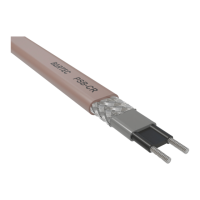For the ESTM temperature controller, the Maximum heating circuit length table please refer to the instructions manual of the ESTM.
Selection of the required components for power connection, control and monitoring, end termination etc.
A typical heating circuit with self-regulating trace heaters consists of:
Power supply / cold lead cable connection
Trace heater splices / junctions (optional)
Control and monitoring units (optional)
End termination
Step 11: Determine the required trace heater power connection kit:
→ Example
From Step 10: 1 Heating circuit with 1 power connection kit = PBS-200-E
Step 12: Determine if control equipment is required:
BARTEC provides a variety of control products, from simple mechanical thermostats to sophisticated digital controllers and control and monitor-
ing systems designed specifically for use with our trace heating products. This section will help you select and specify the right control products
for your application.
General design considerations for temperature control:
When designing your trace heating system, you should consider the following factors.
Adding control elements increases the installation and maintenance costs of the heating system, but allows tighter temperature control, energy
savings and more efficient use of plant maintenance personnel’s time.
The thermal environment of a trace heating system varies greatly, especially at valves, pipe supports, and other heat sinks. It is therefore sel-
dom possible to achieve very tight temperature control.
The temperature of a heat tracing system is based on ambient temperature and can vary by as much as 20 °C when the system is uncon-
trolled. You can choose between 2 approaches for temperature control:

